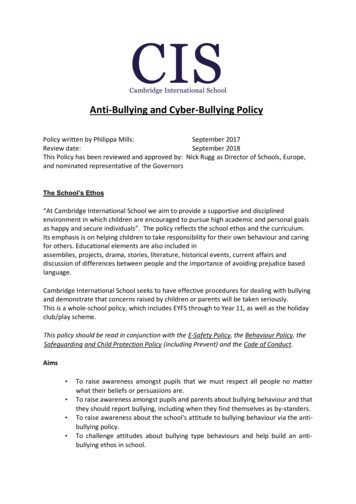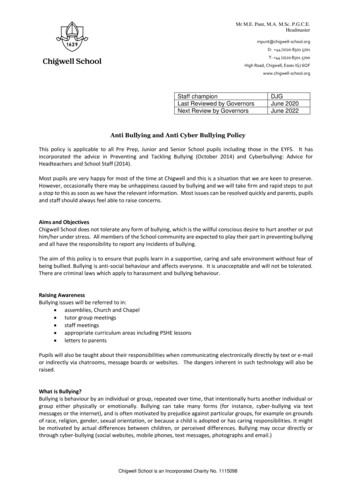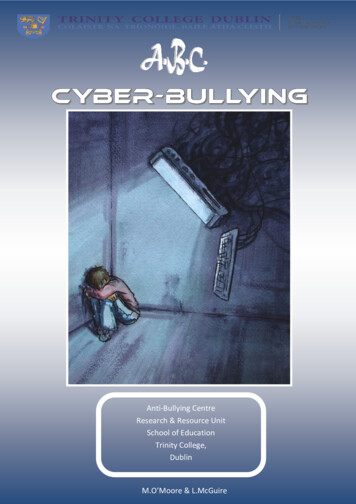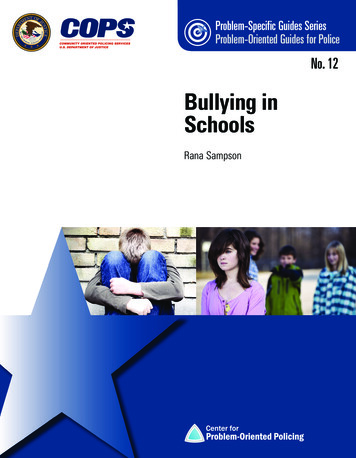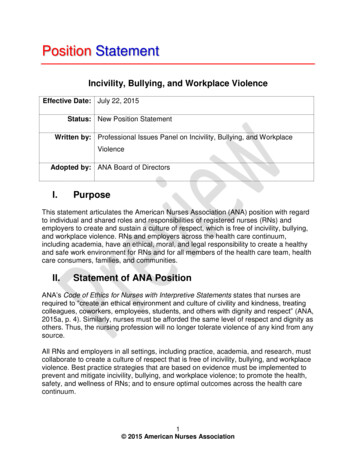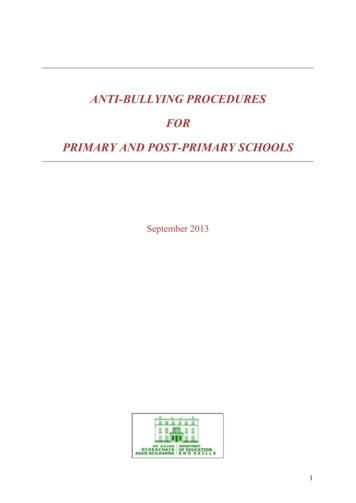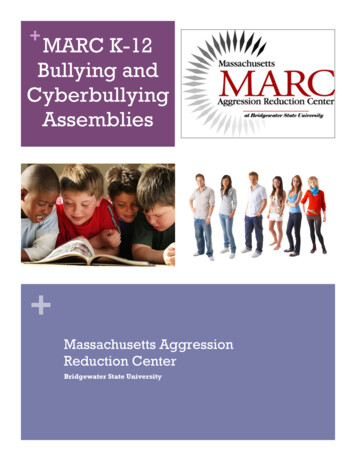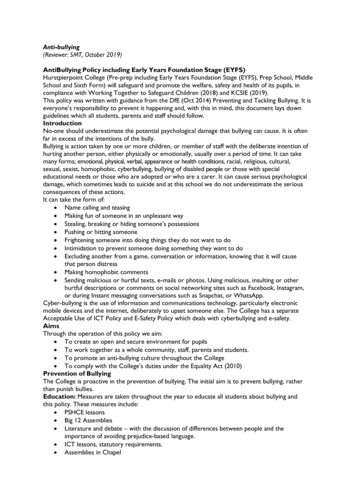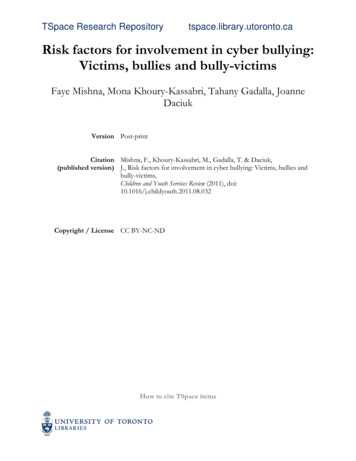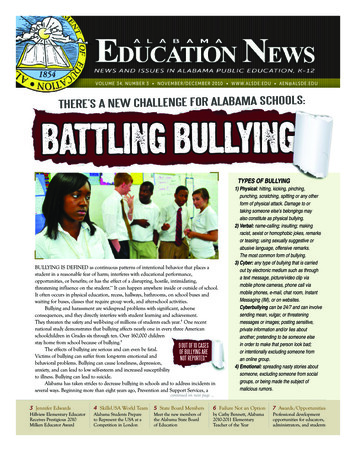
Transcription
AEN-Vol 34 No 3 WEB.qxd11/18/104:01 PMPage 1VOLUME 34, NUMBER 3 NOVEMBER/DECEMBER 2010 WWW.ALSDE.EDU AEN@ALSDE.EDUTHERE’S A NEW CHALLENGE FOR ALABAMA SCHOOLS:TYPES OF BULLYINGBULLYING IS DEFINED as continuous patterns of intentional behavior that places astudent in a reasonable fear of harm; interferes with educational performance,opportunities, or benefits; or has the effect of a disrupting, hostile, intimidating,threatening influence on the student.** It can happen anywhere inside or outside of school.It often occurs in physical education, recess, hallways, bathrooms, on school buses andwaiting for buses, classes that require group work, and after-school activities.Bullying and harassment are widespread problems with significant, adverseconsequences, and they directly interfere with student learning and achievement.They threaten the safety and well-being of millions of students each year.† One recentnational study demonstrates that bullying affects nearly one in every three Americanschoolchildren in Grades six through ten. Over 160,000 childrenstay home from school because of bullying.†9OUT OF 10 CASESThe effects of bullying are serious and can even be fatal.OF BULLYING AREVictims of bullying can suffer from long-term emotional andNOT REPORTED.*behavioral problems. Bullying can cause loneliness, depression,anxiety, and can lead to low self-esteem and increased susceptibilityto illness. Bullying can lead to suicide.Alabama has taken strides to decrease bullying in schools and to address incidents inseveral ways. Beginning more than eight years ago, Prevention and Support Services, acontinued on next page .3 Jennifer EdwardsHillview Elementary EducatorReceives Prestigious 2010Milken Educator Award4 SkillsUSA World TeamAlabama Students Prepareto Represent the USA at aCompetition in London5 State Board MembersMeet the new members ofthe Alabama State Boardof Education1) Physical: hitting, kicking, pinching,punching, scratching, spitting or any otherform of physical attack. Damage to ortaking someone else’s belongings mayalso constitute as physical bullying.2) Verbal: name-calling; insulting; makingracist, sexist or homophobic jokes, remarksor teasing; using sexually suggestive orabusive language, offensive remarks.The most common form of bullying.3) Cyber: any type of bullying that is carriedout by electronic medium such as througha text message, picture/video clip viamobile phone cameras, phone call viamobile phones, e-mail, chat room, InstantMessaging (IM), or on websites.Cyberbullying can be 24/7 and can involvesending mean, vulgar, or threateningmessages or images; posting sensitive,private information and/or lies aboutanother; pretending to be someone elsein order to make that person look bad;or intentionally excluding someone froman online group.4) Emotional: spreading nasty stories aboutsomeone, excluding someone from socialgroups, or being made the subject ofmalicious rumors.6 Failure Not an Optionby Cathy Bennett, Alabama2010-2011 ElementaryTeacher of the Year7 Awards /OpportunitiesProfessional developmentopportunities for educators,administrators, and students
AEN-Vol 34 No 3 WEB.qxd11/18/104:01 PMPage 2section within theAlabama Department of Education,began offering training and resources tostaff and faculty in schools. Manuals andmaterials have long been a part of acounselor’s or teacher’s arsenal to tacklebullying and its effects on students.Baldwin County has also focused onthe possibility of the very worst reactionto bullying by offering resources andtraining on suicide prevention to theirguidance counselors and social workers.The warning signs and symptoms, causes,preventions, and how to communicatewith students, parents, and other lovedones were reviewed at an in-service80-90% OF ADOLESCENTStraining this fall.REPORTED BEING BULLIEDHelping teachers and staff to*DURING THEIR SCHOOL YEARS.understand and act when bullyingincidents occur was also a part of theOn October 1, 2009, the StudentChilton County school district’s plan.Harassment Prevention Act 571 becamePAM HARRIS, Testing Coordinator, andKAREN MITCHELL, School Improvementeffective, protecting students fromSpecialist, were integral in the training ofharassment on school grounds or atthe entire staff and faculty. The teachers,school events. Based on the state law,counselors, and even bus drivers receivedthe Alabama Department of Educationprofessional development in the daysdesigned a model policy for local districtsbefore school started on the new policyto use in developing their own. All localand its implementation, butdistricts were to establish policies on orSuperintendent KEITH MOORE wanted tobefore July 1, 2010. In addition to thehave more instruction and hands-onpolicies, local districts are usinglearning. To add to the professionalinnovative events and informativedevelopment, Moore invited JAY BANKS,professional development to put thewho created the STAMP OUT Bullyingpolicy into action. In Baldwin County,program, to the district.the staff, including PATRICE HARRIS,Intervention Supervisor, has offeredThe STAMP OUT Bullyingextensive learning to help students feelprogram provides a mixture of educationconfident and comfortable at school.and entertainment geared towards“For so long we’ve looked the other waymaking students feel comfortable andor didn’t know when or where to look.less hesitant to reporting bullying.Some have thought, ‘Oh, its justBanks trained teachers and staff inhorseplay’, but the incidents and effects“marathon style” professionalwere much more serious than that.development meetings for more than aWe need to address it now,” said Harris.week and then went to all 11 schools toAfter the Baldwin County policyhold assemblies with the students.was developed and implemented, allPam Harris said of Jay Banks’ style thatprincipals had extensive professionalhe “really had the attention of thedevelopment meetings and were givenstudents and used humor to relate thedetailed instructions on the responsibilityissues to the students.” The students werethey had in putting the new policy intovery engaged, and positive feedback wasaction. Anti-bullying Powerpointoffered by those who attended thepresentations wereassemblies.shared in every schoolSince theand addressed differentprofessional71% OF TEACHERS SURVEYED MAINTAINEDtypes and how to lookdevelopmentTHAT THEY ALWAYS INTERVENE DURING SUCHfor bullying. The districtandSITUATIONS. HOWEVER, 71% OF STUDENTSalso has conducted ainteractiveDIDN’T REPORT BULLYING BECAUSE THEYsurvey of teachers andassemblies,*DON’T THINK TEACHERS CARE.students to try toChiltonpinpoint the areas inCounty haswhich harassment is taking place and toseen more students reporting incidents,get more feedback on the subject.showing a more aware and alert studentcontinued from front .aen l 2population. The faculty and staff nowintend to build on the training theyreceived with follow-up meetings that willfocus on a consequence plan for dealingwith bullies, development of specificinterventions, and a principals’ groupwork session.So what more can be done toprevent bullying in Alabama schools?It is essential for administrators,counselors, teachers, students, andparents to work together to ensureprogram success. Teachers across the stateare receiving detailed professionaldevelopment, and students are engagingin presentations and assemblies thatallow them to learn more and teach themhow to speak out. Parents are the next15-30% OF STUDENTSREPORT BEING VICTIMS OFBULLYING REGULARLY.*group that school officials and teachersare working with to get more involved inpreventing bullying. If bullying occurs, itcan best be tackled by parents andteachers working together.Resources are available to helpparents who are worried about bullyingin schools. Guidance counselors andteachers are open to hearing and helpingwith the concerns of parents. BaldwinCounty has reached out to its parentswith two brochures that are availableonline at www.bcbe.org. Guidancecounselors also have specialized resourcesfor parents and can offer these duringparent-counselor meetings.The challenge of ending harassmentand bullying at schools is one thateducators and parents are embracing.With knowledge, support, andunderstanding, we can help to ensure allstudents feel safe in Alabama schools.SOURCES:*U.S. Dept. of Education’s National Centerfor Educational Statistics, 2007.**Student Harassment Prevention Act 571.† Bridging the Gap in Federal Law:Promoting Safe Schools and ImprovedStudent Achievement by Preventing Bullyingand Harassment in Our Schools, June 2007.
AEN-Vol 34 No 3 WEB.qxd11/18/104:02 PMPage 9One School’s SolutionFoley Middle School (Baldwin County) AchievesCertified Peer Program StatusFoley Middle School’s Peer Helper Program trains students to help theirpeers resolve conflicts in a non-violent manner.PROGRAM GOALS ARE:1. To improve our school environment bydecreasing tension and hostility; and2. To resolve peer disputes which interfere withacademic achievement/the education process.Rationale: Our rationale is that students can learn from other students how tosolve their conflicts responsibly and constructively.“Students are trained to mediate, intervene, work together to solveproblems and to help one another during aftermaths of tragedies likefatal student car wrecks,” explained TERRY WILHITE, Director ofCommunications for the Baldwin County Schools. “We have PeerHelpers in our high schools, and we’re working to eventually cover allmiddle schools, too.Foley students have shown great commitment to this effort. PeerHelpers meet three days a week. They help other students to resolve theirconflicts peacefully and act as “buddies” to new students, assisting in asmooth transition to their new school environment. The curriculum forthe Peer Helper Program at Foley Middle is Mediation: Getting to Win Win.The Peer Helper Coordinator meets monthly with the peer helpers todiscuss any issues and to review mediation procedures.“Peer Helpers have accepted the responsibility of performing a veryimportant service for our school. They have an opportunity to make adifference in the lives of their classmates,” said KATHRYN DOYLE,coordinator of the peer helper program.The Jennifer Claire Moore Foundation sponsors Foley MiddleSchool’s Peer Helpers, which include eight 8th graders trained in peermediation. Referrals are made to peer mediation by an administrator,teacher, counselor or the disputants themselves. Types of conflictsinclude: teasing, threats, name calling, rumors, friendship, property anddisruptive arguing. Peer pressure and bullying can occur over parentaldivorce, weight issues, sickness, death, depression, race or sex.“We use the school website to inform parents and the communityabout our peer helper program. The Foundation holds an annual Rodeoto raise money and promote awareness of peer helper programs,”according to Mrs. Doyle.The Peer Helper Program was designed as a part of the JenniferClaire Moore Foundation Inc. to provide a support group among highaen l 3school students. The program began at Foley HighSchool and is now active at five other BaldwinCounty high schools: Gulf Shores High School,Robertsdale High School, Daphne High School,Baldwin County High School and BaysideAcademy (private school). In addition to FoleyMiddle School, there are Peer Helper Programs atfour other Baldwin County middle schools: BayMinette Middle School, Elberta Middle School,Fairhope Middle School and Summerdale School.NATIONAL PEER HELPERS CONFERENCE:Opportunities for Establishing or Expandinga Peer ProgramFeb. 20-22, 2010, Perdido Beach ResortSponsored by Jennifer Claire Moore Foundation andNational Association of Peer Program ProfessionalsFoley Middle School Principal: Mr. Branton V. BaileyBaldwin County Superintendent: Dr. Alan LeeState Board Member, District 1: Randy McKinney
AEN-Vol 34 No 3 WEB.qxd11/18/104:01 PMPage 3Jefferson County Teacher Wins “Education Oscar”“Whatever you want to do in life, I want you to seek it,believe it and pursue it. – Jennifer Edwards”A SENSE OF HUMILITY AND PASSION for her students earned JENNIFER EDWARDSthe Milken National Educator Award and 25,000! The Jefferson County teacher receivedthe “Education Oscar” at a surprise schoolwide assembly at Hillview Elementary School.The entire school gathered in the gymnasium to hear the extraordinary news that one of itsown would receive an unrestricted 25,000 financial reward and an all-expense-paid trip tothe annual Milken National Education Conference next year.Senior Vice President of the Milken Educator Awards DR. JANE FOLEY, along withSTATE SUPERINTENDENT OF EDUCATION JOSEPH B. MORTON, presented the prestigious MilkenNational Educator Award and 25,000 to the very surprised third grade teacher.The announcement came during the Milken Foundation’s 24th annual coast-to-coast tourto reward the nation’s top educators with more than 1.3 million in cash awards.The “Education Oscar” recognizes teacher-leaders in the early to middle part of theircareers who are innovative and effective. There is a rigorous and confidential selectionprocess. Teachers cannot apply for the award. Educators are recommended without theirknowledge to the Milken Family Foundation. “You don’t find us,” explained Dr. Foley.“We find you.”The award honors the exceptional work of educators as a model for the state andnation. The Milken Family Foundation’s 24th annual National Notifications Tour honored55 outstanding educators and is the nation’s largest teacher recognition program.Dr. Morton praised Alabama’s 2010 Milken Educator: “Mrs. Edwards is a dedicatedprofessional educator.She is a NationalThe Milken Award says in a very public way thatBoard Certifiedgreatness in education should be recognized.Teacher and was– Dr. Jane Foley, Senior Vice President, Milken Educator AwardsJefferson County’sElementary Teacher of the Year for 2009-2010. She inspires her young students to want tolearn and to be successful. She is respected by her peers who describe her as the type ofteacher you would want for your own child. It is a privilege to honor Jennifer Edwards another exemplary Alabama teacher - as Alabama’s 2010 Milken Educator.”Described by her colleagues as “one of the best teachers in the district,” JenniferEdwards mentors new teachers every school year and volunteers to ride the school busevery morning – beginning at 6:40 a.m. – to tutor students who cannot stay for after-schooltutoring. She also gave every student a multiplication rap CD to take home.Edwards earned her bachelor’s and master’s degrees inElementary Education and certification in Education Leadershipfrom Auburn University Montgomery. She also earned anassociate’s degree in Elementary Education from AlabamaSouthern Union Community College. She is a National BoardCertified Teacher in Literacy: Reading-Language Arts/Early andMiddle Childhood. Edwards has taught third grade at HillviewElementary in the Jefferson County School System since 2006.Since Alabama joined the Milken Educator Awards programin 1998, 28 Alabama educators have received the “EducationOscar” and a total of 700,000. Awards alternate yearly betweenelementary and secondary educators. In recognizing these”“aen l 4Jennifer Edwardsoutstanding teachers with 25,000, the Foundation hopesto raise public awareness thathigh-quality teachers areessential to student achievement.The award was developed toreward, retain, and attract thehighest quality K-12 teachers.Edwards joins the MilkenEducator Network, a nationwidecoalition of more than 2,500 topeducators who have access to avariety of professional resources tohelp cultivate and expandinnovative programs in theirclassrooms, schools, and districts.For more information on theMilken Family FoundationNational Educator Awards, visitwww.mff.org or theAlabama Departmentof Education’s websiteat www.alsde.edu.
AEN-Vol 34 No 3 WEB.qxd11/18/104:02 PMPage 11Students Represent America at World Team Competition in LondonStrong K-12, Postsecondary, Higher Education Partnership Continues to Benefit StudentsThree of Alabama’s top postsecondaryeducation students – Raychel Bland,Joseph King, and Bradley Wright – havebeen selected to represent the UnitedStates at the 2011 WorldSkillsCompetition in London, England, onOctober 5-8. Each of these students joinedSkillsUSA while in high school, and isnow considered to be some of America’stop collegiate students.“This is a great example of howstudents are benefiting from the strongpartnership that exists between our state’sK-12, Postsecondary, and HigherEducation systems,” says Alabama Careerand Technical Education Director SherryKey. “We must continue to work togetherin the future to ensure students continueto realize their full potential and have anopportunity to experience a lifetime ofsuccess.”SkillsUSA is a national studentorganization that is devoted to preparinghigh school students for academicachievement, postsecondary learning, andfor careers in technical-relatedoccupations. More than 300,000 studentsand top business professionals nationwideare members of SkillsUSA. Currently,Alabama has almost 10,000 SkillsUSAmembers.“I started as a cosmetology student atsixteen. I attended the Dothan TechnologyCenter, and it was there I found my nicheas a makeup artist,” says Lurleen B.Wallace Community College BeautyTherapy Student Raychel Bland. “Igraduated in 2008 with honors and anadvanced technical diploma, and earned ascholarship. Now as a board certifiedesthetician, I am working and furtheringmy education to reach my ultimate goal ofbecoming a premier makeup artist.SkillsUSA continues to provideopportunities for me to show my talent insomething I'm most passionate about. It’struly an honor to represent the U.S. in the WorldSkills Competition.”“I joined SkillsUSA in 2005 when I was in the tenth grade and placed secondin the state,” says Wallace Community College Masonry Student Bradley Wright.“My high school instructor, Mr. Charles West (Earnest Pruett Center forTechnology), introduced me to SkillsUSA. He played an instrumental part in mebecoming a mason. After my first competition, I was hooked on becoming theworld’s best bricklayer and during the next few years, I won first-place in the stateand national competitions. Since joining SkillsUSA and learning about theWorldSkills competitions, it has been my dream to be selected to represent the U.S.in the bricklaying competition. I am willing to devote the time for training andpreparation, and will do my bestin London.”Teaching focused anddetermined students like BradleyWright has continued to inspireWallace Community CollegeRaychel BlandJoseph KingBradley WrightInstructor Kenny AllenBeauty TherapyCNC MillingMasonry/Bricklayingthroughout his teaching career.“Bradley is a unique student – he is most certainly one of a kind,” says Allen.“When Bradley came here, he traveled four hours one way. I did not know where hewas living until one day while we were talking, and he told me he was living in a RVby himself. He was only eighteen-years-old, and I could not believe it. He lived thisway the entire time that he was here, cooking his own food and washing his ownclothing. As I said, he is certainly a special student who knows what he wants and iswilling to work for it.”SkillsUSA also emphasizes the importance of having high ethical standards, adedication to community service, and the motto “pride in the dignity of work.”Calhoun Community College Student Joseph King first joined SkillsUSA in2003 while attending the Limestone Career Tech Center. “I participated in local andstate competitions during high school,” says King. “When I started machiningclasses in college, Calhoun was not a member of SkillsUSA yet. Shortly after theygot a new Dean of Technologies – Mrs. Bethany Clem – and she brought SkillsUSAto Calhoun Community College. When I started my CNC (computer numericcontrolled) classes my instructor pushed me to participate in the CNC Millingcompetition, so I did. I place
The most common form of bullying. 3) Cyber:any type of bullying that is carried out by electronic medium such as through a text message, picture/video clip via . assemblies. Since the professional development and interactive assemblies, C
